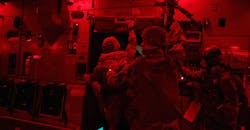A night parachute jumps is a great test of leadership and resilience, because it is a leap into the unknown. At the start, the aircraft looks like a subway car full of people wearing 200 lbs. of parachutes, overstuffed rucksacks, and weapons in 4-ft., padded duffel bags. Approaching the drop zone, the few white lights go out, the soldiers strap on helmets, and red lights bathe the cabin in a lukewarm glow. Minutes before the drop, the rear cargo ramp goes down, and the plane’s interior becomes a dark hole of wind, noise, cold, and unknown.
One minute before the drop, soldiers face the howling wind roaring from the black, open exit. Their yellow static lines are hooked to long, thick cables running the length of the aircraft, and everyone is desperately trying to remain upright through the turbulence as the plane nears the drop zone. The jumpmaster looks out one last time, watches as the red jump light turns green, yells “Follow Me!”, and walks off the ramp, to be followed by the rest, disappearing into the howling blackness.
At night, you cannot see the ground or water, or if you are dropping into tall trees or an open field. U.S. Special Forces do a lot of night parachute jumps, and SF soldiers develop resiliency skills, to be equally prepared and unsurprised when an operational plan diverges quickly into the unknown.
Know your organization’s purpose. When you land at night, after putting your weapon into action and securing your equipment, the most important thing is to use your compass to find True North. Gaining your sense of direction is critical for each soldier. Each soldier must move through the darkness on his own but everyone in the unit must be moving together to a specified assembly area, to continue the mission. Finding True North is equivalent to defining a purpose for people and organizations. In unknown situations, conditions and resources may have changed, but purpose and direction remain unchanged. Always ensure everyone knows your direction and purpose.
Remember people accomplish every mission. The U.S. Army has a motto, “Mission First, Soldiers Always,” combining two contrasting elements: It clearly recognizes the importance of accomplishing the mission; and it maintains that, without people, the mission will not be accomplished. Too often, when events, conditions, and resources begin to overwhelm us, we start to take people for granted. People are always the means to accomplish any mission, especially when times are most difficult.
Over-communicate purpose and success. In the minutes before a parachute drop, the jumpmaster gives a series of jump-readiness directions that are highly standardized, using both motion commands and voice commands. This is because those moments before jumping are vitally important for safety and mission success. Using “over-communication” and continuous communication reduces soldiers’ stress when conditions are most dangerous.
Do the best you can in the next 5 minutes. In stressful and unknown situations, success can be found by breaking time into very small pieces: Worry only about your immediate success, what you can control, and not what is out of your control. Focus on the next 5 minutes and no longer. In the unknown, your mind can become the enemy that wants to worry and overreact, to “believe” that success cannot be achieved. In difficult and trying times, focus solely on doing well over the next five minutes, and only that, no matter what.
Apply commander’s intent to ensure initiative. Improvisation and experience can overcome changing conditions. “Commander’s Intent” describes what success will look like at the end of the operation. “Did we drive off the enemy?” “Did we make the road safe?” “Did we bring the equipment into the village?” During mission planning, all soldiers understand what they are doing and why they are doing it. Understanding what the commander wants to achieve and what success looks like is the why of the mission. In an enterprise, this means all employees know what the CEO expects as an outcome. Employees know their plan of action but adaptability is built in, so that even if the mission strays off course success can be met every time, using soldiers’ initiative.
We must venture into the unknown to be successful. Success is never assured, but it can be achieved when we know our direction and purpose, when we value our team, when we over-communicate our purpose, when we focus on building small successes into large wins, and when we clearly describe success so our team can use their initiative. The unknown always becomes known and when we put fear aside, embrace the challenge, and believe in our team, we can find success in the most daunting conditions.
About the Author
Chad Storlie
Chad Storlie is a retired U.S. Army Special Forces Lieutenant Colonel with 20+ years of active duty and reserve service in infantry, Special Forces, and joint headquarters units. He is an adjunct Professor of Marketing at Flagler College, a mid-level B2B marketing executive, and a widely published author on leadership, business, military and technology topics.
